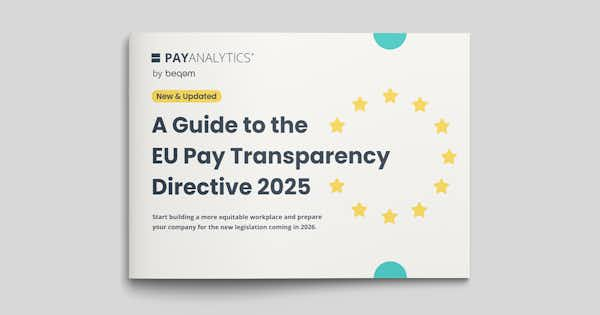A Guide to the EU Pay Transparency Directive 2025 | Download our eGuide for free

What is the Canada Pay Equity Act?
The idea behind the Pay Equity Act is to create a system that ensures equal pay for work of equal value. An employer should pay the same for all the different jobs that contribute equal value to its operations.
In May 2024 we published an e-book on The federal pay equity act and pay transparency laws in Canada. It is available to download for free and provides information on how the landscape of pay equity and pay transparency in Canada has evolved in recent years.
The Pay Equity Act protects about 1.3 million employees working for nearly 4,600 federally regulated employers.
The Pay Equity Act obliges Canadian employers with ten or more employees to eliminate pay inequity between women and men who perform work of comparable value to their organization.
This law is unique in that it enforces employers' duty to define, using a gender-neutral system, the value each job brings to the organization. In addition, the law makes the organization responsible for evaluating which jobs are male-dominated and female-dominated, measuring differences in pay, closing pay gaps, and reporting to the government.
Employers must demonstrate that they compensate equally for work of comparable value done by men and women. Further, they must maintain this equitable compensation structure over time.
The goal of the Pay Equity plan is to correct any pay equity gaps by increasing the compensation of employees in jobs that are not receiving equal pay for work of equal value. As a result, the following timeline is established by the act:
The timeline
By November 1, 2021 – Inform employees about the pay equity process.
In the following two years, employers are required to:
Establish a pay equity committee.
Develop a pay equity plan.
By September 3, 2024 – Employers must post their final pay equity plan and notice the dates of pay increases.
Correct any pay equity gaps by increasing the compensation of employees in jobs that are not receiving equal pay for work of equal value.
Starting September 4, 2024 – Increases in compensation must occur if pay equity gap is found.
Depending on the organization’s size, employers may be eligible to phase in increases between 2024 and 2029.
By June 30, 2025 - Employers must file the first statement on the pay equity plan to the Pay Equity Commissioner.
Employers are then required to:
File annual pay equity plan statements
The pay equity plan must be updated and re-posted every five years (first re-posting to happen no later than September 4th 2029)
Pay Equity committee
Employers of any size may decide to form a pay equity committee on their own initiative. However, forming a pay equity committee is obligatory for employers with 100 or more employees. Employers with ten or more employees must form a committee if the employees belong to a trade union.
The pay equity committee must be composed of at least three members, at least half of them must be women. At least one member must be selected by and represent the employer; two-thirds of the members must represent either the employees themselves or their union representatives.
Committee members participate in developing and updating the pay equity plan. However, the employer holds the ultimate responsibility for the plan.
Pay Equity Plan
Employers must establish a pay equity plan which lays out the approach to measure pay equity. This approach includes a single method to value all work performed across all job classes. The pay equity plan applies to all employees, no matter the branch, division, or region in which they may work.
In the Pay Equity Plan the employer
Identifies job classes in the workplace.
Determines which job classes are commonly held by women and which are commonly held by men.
Values the work done in each of these job classes.
Analyzes pay by job classes.
Determines whether there are differences in compensation between jobs of equal value.
Increases in compensation
The results of this analysis help pinpoint the job classes and employees that are entitled to pay increases based on the employer’s plan. Sometimes this analysis will indicate that employees are entitled to increases. Before making those increases, employers must post a notice of the increases with the date they are payable.
How can PayAnalytics help Canadian employers on their way to pay equity?
The Pay Equity Plan
PayAnalytics fully supports the federal mandated equal pay act. For example the built-in job evaluation wizard helps organizations build their pay equity plans, tailored to their unique compensation strategies and internal values; organizations can develop their gender-neutral job evaluation within our platform or apply ready-made templates.
Our analytics can analyze differences and compare different job classes of equal value, by any pay component, broken down by gender.
The mandated correction approaches will be fully integrated to the platform and optimized.
Pay Equity across groups and amongst employees
PayAnalytics does not only support the goals of the federal pay equity act aimed at addressing underpayment of certain jobs; PayAnalytics brings pay equity to employees within the same job role, with a world leading pay equity platform.
Furthermore, the PayAnalytics software suggests salary changes to correct any discrepancies primarily attributable to the pay gap.
PayAnalytics goes beyond gender, providing analysis by any secondary demographic value, and their intersection.
PayAnalytics fully supports the equal pay legislation in Manitoba, Ontario, Quebec, New Brunswick, Nova Scotia and Prince Edward Island. (The provincial legislation applies to the public sector only, except in Ontario and Quebec, where all except the smallest private-sector workplaces are covered).
Do not hesitate to contact us for further inquiries or book a meeting to demonstrate the software. You can find more information on PayAnalytics on our website.
Find out if the Pay Equity Act applies to you or your workplace here.
You can find templates of Pay Equity notices here.
For more tools and resources on the Pay Equity Act, visit payequitychrc.ca.
Margrét Bjarnadóttir, founder of PayAnalytics on the podcast "Level the Paying Field" that discusses the Pay Equity Act, can be found can be found here.
The information on this page is not intended to serve and does not serve as legal advice. All of the content, information, and material in this article are only for general informational use. Readers are advised that this information, legal or otherwise, may not be up-to-date.






